MXA RACE TEST: THE REAL TEST OF THE 2021 KAWASAKI KX450
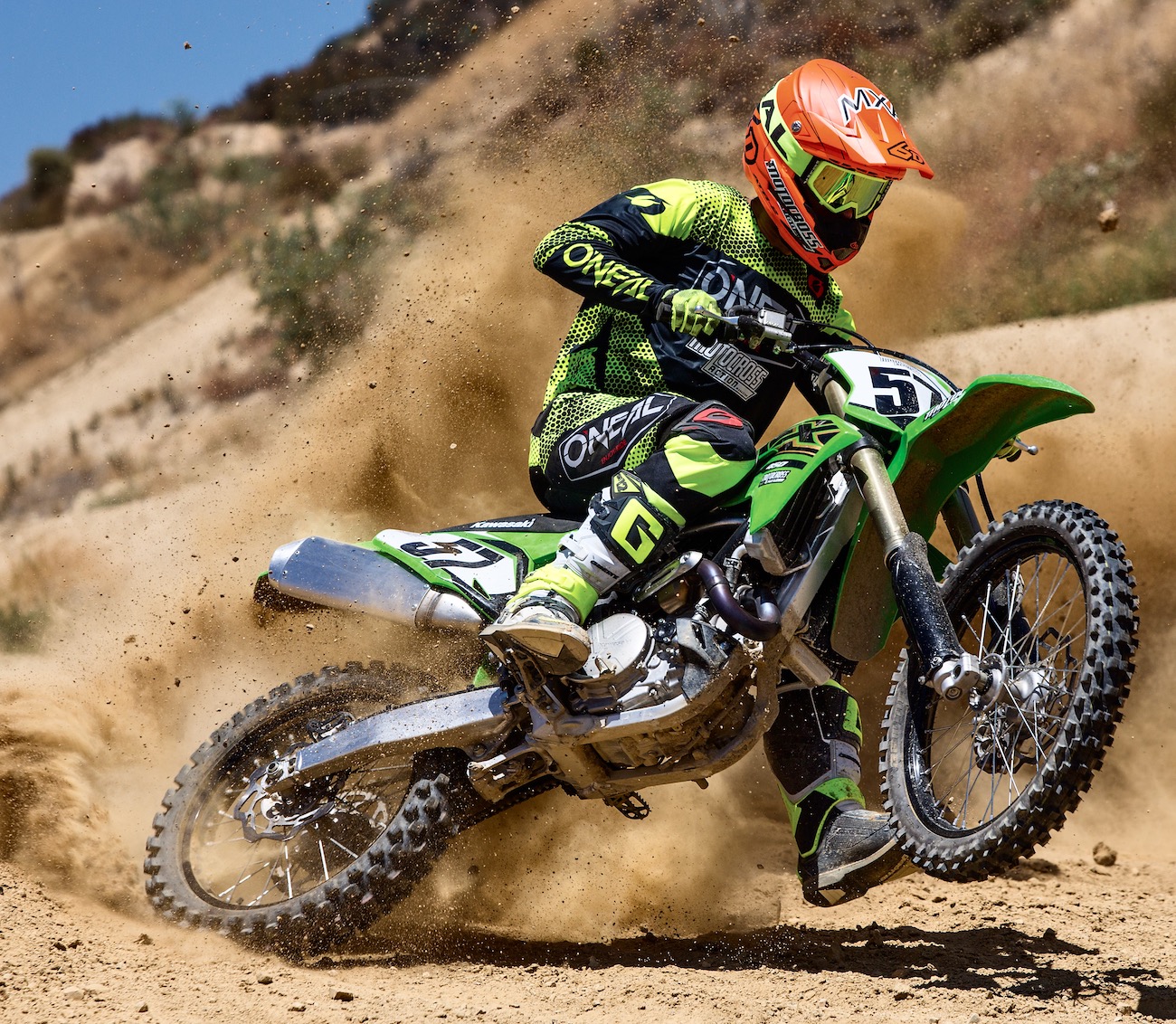 THE GEAR: Jersey: O’Neal Mayham Covert. Pants: O’Neal Mayham Covert. Helmet: 6D ATR-2 .Goggles: Viral Brand Factory Series. Boots: Gaerne SG-12.
THE GEAR: Jersey: O’Neal Mayham Covert. Pants: O’Neal Mayham Covert. Helmet: 6D ATR-2 .Goggles: Viral Brand Factory Series. Boots: Gaerne SG-12.
Q: FIRST AND FOREMOST, IS THE 2021 KX450 BETTER THAN THE 2020 KX450?
A: Yes, it is better. Kawasaki made five changes for 2021. That is actually more changes than Kawasaki made to the 2019 for the 2020 model year. But, with the exception of the new clutch, most of the changes are cosmetic or minor.
Q: WHAT’S NEW ON THE 2021 KAWASAKI KX450?
A: Here is the quick list of 2021 model updates, but reallythe only mechanical change of any import is the clutch.
(1) BNG. Kawasaki redesigned its radiator shroud graphics, although the plastic is unchanged.
(2) Tires. Dunlop claims that it is moving away from the MX3S tires. We bring this up because we prefer the older MX3S front tire to the new-school Dunlop MX33. Yes, the MX3S does throw knobs off the front tire’s sidewall, but only if you run the intermediate tire on hard-pack dirt that it wasn’t designed for. We’ll risk it to get the added grip of the 2021 KX450’s MX3S over the other brands MX33s.
(3) Handlebars. Mark this moment down in your diary alongside your first kiss, first trophy and first time eating kimchi. The 2021 KX450 comes with oversized 1-1/8-inch handlebars. The last vestige of 7/8-inch bars on modern full-size motocross bikes has now disappeared. The KX450’s bars are Renthal 839-bend Fatbars; they are Honda bars. What hasn’t disappeared is Kawasaki’s wimpy, marshmallow-like rubber bar-mount inserts. The bars don’t bend every time you crash, but the bar mounts twist every time.
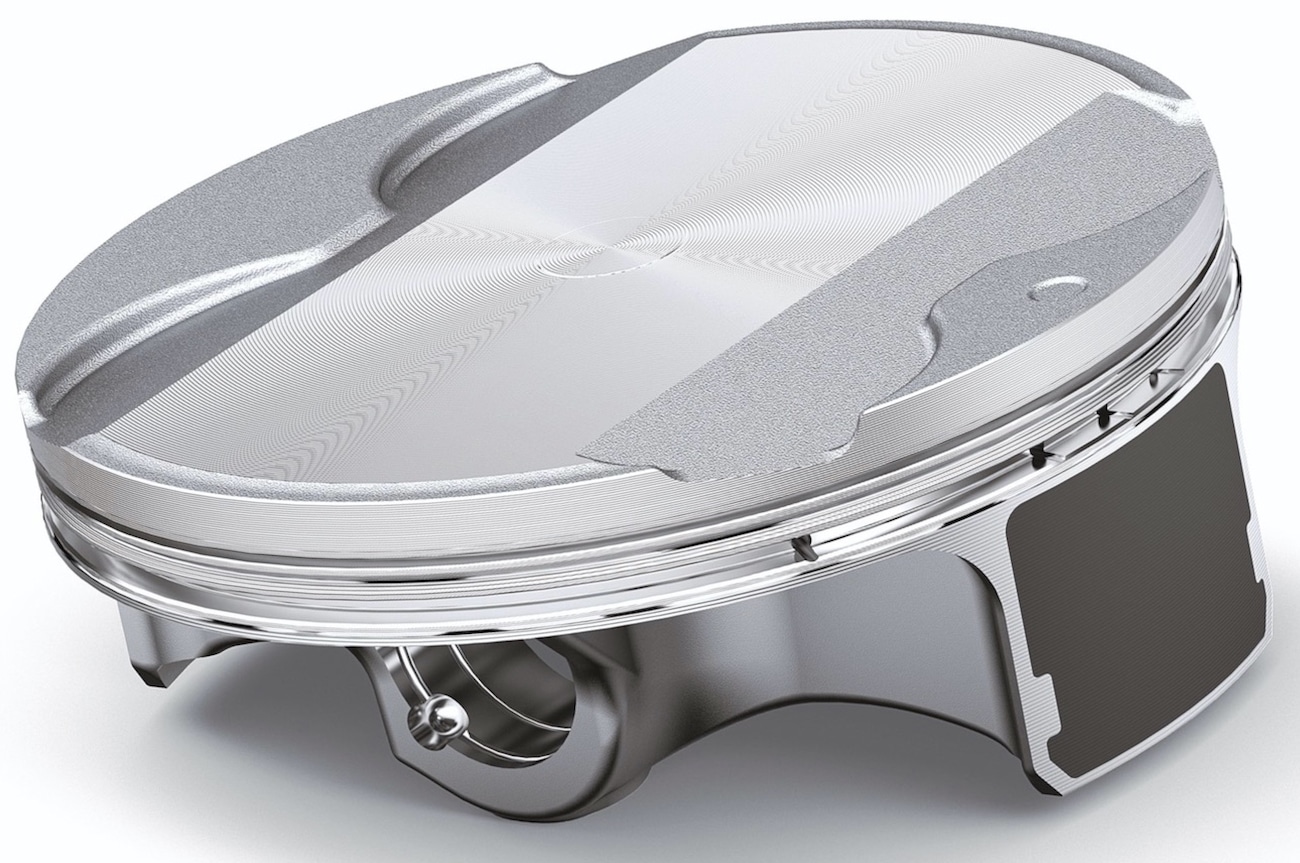 (4) Piston. The 2021 KX450 piston itself is unchanged dimensionally from last year. It gets a dry-film lubricant coating on the piston skirts that reduces friction at low rpm and helps with the piston bedding-in process. The coating thickness of the CT-3 coating is 1 to 1.5 mil (12 to 37 microns).
(4) Piston. The 2021 KX450 piston itself is unchanged dimensionally from last year. It gets a dry-film lubricant coating on the piston skirts that reduces friction at low rpm and helps with the piston bedding-in process. The coating thickness of the CT-3 coating is 1 to 1.5 mil (12 to 37 microns).
(5) Clutch. Last year, in our 2020 Kawasaki KX450 test, we wrote, “The KX450 clutch is hydraulic, which is a nice touch, but it’s not as good as the hydraulic clutches on the European brands. Kawasaki may have added hydraulic pressure to activate the push rod, but they did very little to beef up the actual clutch mechanism itself.” In short, good hydraulics cannot overcome a bad clutch. We don’t know if Kawasaki’s engineers knew this when they added the new clutch master cylinder to the old clutch, but they learned it during the 2020 season. The result of this newfound knowledge is a vastly improved clutch mechanism for 2021.
 There is no way around it, the Belleville washer clutch spring has been borrowed from KTM, but it is a big improvement over the 2020 clutch.
There is no way around it, the Belleville washer clutch spring has been borrowed from KTM, but it is a big improvement over the 2020 clutch.
The 2021 clutch has a 7mm-larger (146mm) clutch basket, which translates into 7mm larger clutch plates. The clutch’s fiber clutch plates also have the fiber segments applied in an angled pattern to help move oil from between the fiber and steel plates.
There is more good news: Kawasaki got rid of the judder spring system, which MXA test riders hate, and replaced it with a full-size eighth plate. And, the best news is that Kawasaki replaced the five individual coil-type clutch springs with a Belleville washer, a la KTM and Husqvarna. Unlike the five separate coil springs on all previous Kawasaki clutches, the large-diameter Belleville washer applies pressure to the clutch pack evenly around its circumference.
 The strong points of the 2021 KX450 engine are that it runs with a brisk, clean, light and quick-revving feel. The downside is that the KX450’s horsepower is down a couple horses to the competition.
The strong points of the 2021 KX450 engine are that it runs with a brisk, clean, light and quick-revving feel. The downside is that the KX450’s horsepower is down a couple horses to the competition.
Q: HOW DOES THE 2021 KAWASAKI KX450 RUN ON THE TRACK?
A: The KX450 powerband is popular with the MXA test crew. The delivery is extremely usable. It runs with brisk, clean, light and quick-revving throttle response. In real dirt, the KX450 produces a nice spread of power that jumps from the low-end to the midrange to the top-end with little or no hesitation. It delivers the proper amount of power for the situation at hand.
However, there are some issues with the 2021 KX450’s power. First, throttle response at low rpm is jerky. The engine has a weird hit when the throttle is first turned. Second, the Kawasaki KX450 engine isn’t very powerful. Luckily, the power delivery is good enough that it makes you forget that the 2021 KX450 makes less horsepower than every other 450 on the starting line (with the exception of the RM-Z450).
Q: WHAT ARE THE 2021 KX450 DYNO NUMBERS?
A: As much as MXA test riders like the 2021 KX450 engine, it isn’t a powermonger When you compare the 2021 KX450 to the 2021 Husky FC450 , Honda CRF450, Yamaha YZ450 or KTM 450XF. Fo example, at peak, the 2021 Yamaha YZ450F makes 58.56 horsepower, the Husqvarna FC450 58.49 horsepower and the Kawasaki KX450 56.94 horsepower. In short the KX450 ranks fifth sixth lowest out of the seven 2021 450 MX bikes. When it comes to torque, the Honda makes the most (37.13 pound-foot), while the Kawasaki’s 36.26 pound-foot leaves it fourth out of seven. For 2021, Kawasaki has allotted its R&D money to the 2021 KX250. That means the KX450 had to make due with oversized bars, a larger clutch, coated piston and BNG.
For 2021, Kawasaki has allotted its R&D money to the 2021 KX250. That means the KX450 had to make due with oversized bars, a larger clutch, coated piston and BNG.
Q: HOW DID THE 2021 SHOWA SUSPENSION PERFORM?
A: Every 2021 motocross bike that runs the Showa coil-spring forks touts them as being A-Kit copies. We’ll accept that on face value, but is it really worth claiming that your 2021 forks are using technology from a decade ago? The claim isn’t false; it is just exaggerated. There are absolutely none of the A-kit’s tight tolerances or special parts that made them the choice of factory riders. We accept that some A-kit tech would eventually trickle down to production forks, because that is how development works.
Plus, if these are A-kit forks, they aren’t set up properly for a wide range of potential 2021 Kawasaki KX450 racers. That said, they were plush, comfortable and, best of all, followed the ground well. But, no MXA test rider, from a fast Vet to a quick Intermediate to an AMA Pro, could race with these forks in their stock setup. They would bottom out over a Snickers wrapper.
 Just as with the 2020 KX450 forks, the 2021 forks are too soft. We juggled forks springs to suit each test riders weight or speed.
Just as with the 2020 KX450 forks, the 2021 forks are too soft. We juggled forks springs to suit each test riders weight or speed.
Q: WHAT’S THE SIMPLEST WAY TO FIX THE KX450F FORKS?
A: The 2021 KX450 forks are too soft. No surprise! They were too soft in 2020. There is a simple solution for both fast and slow riders. Kawasaki’s stock spring rate is 5.0 N/mm. It works for lightweight riders, Vet Novices, and guys who don’t jump. Thankfully, Kawasaki offers optional 5.2 N/mm fork springs. MXA’s faster or heavier test riders opted for the stiffer 5.2 fork springs. For the Vet test riders, we went with a 5.1 N/mm spring rate; which we achieved by running a stock 5.0 spring in the right fork leg and an optional 5.2 spring in the left fork leg. Voila! By math magic, we had a 5.1 N/mm spring. And, for light and slow test riders, we left the stock 5.0 N/mm springs in and added fork oil in both legs in small 5cc increments to lessen bottoming. Short of sending your KX450 forks out for a re-valve, this is the simplest fix.
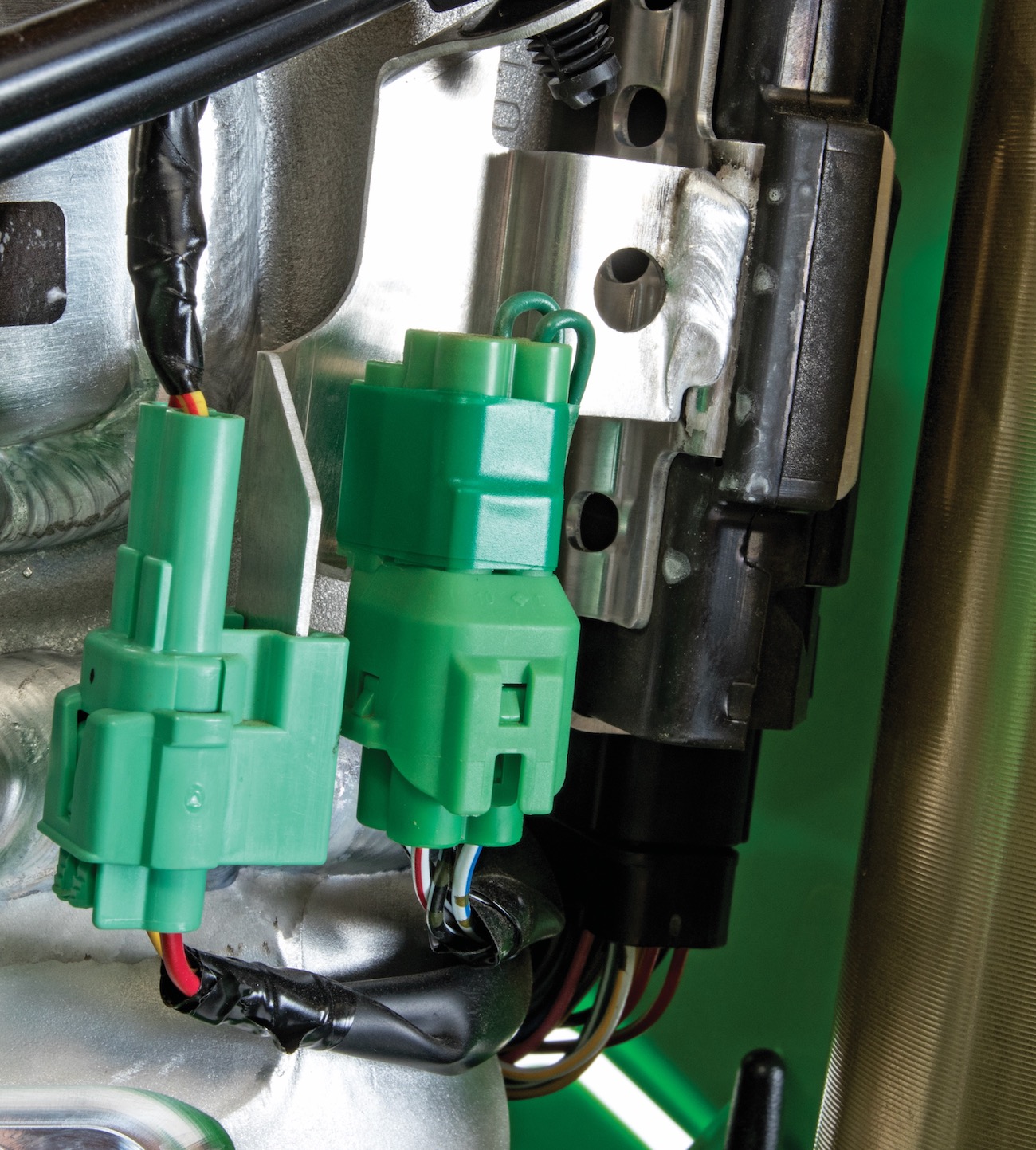 Kawasaki uses plug-in couplers, the green one (shown here) is the stock map, the black one is the mellow map and the white one is the aggressive map.
Kawasaki uses plug-in couplers, the green one (shown here) is the stock map, the black one is the mellow map and the white one is the aggressive map.
Q: HOW DO YOU CHANGE THE MAPS ON THE 2021 KX450?
A: There is no push button to press as on the KTM, Honda, Husky or Yamaha.The easiest way to change maps is to use the supplied green, black and white plug-in couplers. The green plug-in is the stock KX450 map. The black coupler mellows out the complete rev range from zero to 11,500 rpm. If you compare the black map to the green map, the black map gives up 1 to 2 horsepower from 6000 rpm all the way to 11,500 rpm. The white plug-in is the aggressive coupler. It produces the exact same horsepower from bottom to top as the stock green coupler. The aggressive white map doesn’t make more power; it just delivers that power with a crisper feel. But, the average racer will like the usability of the green coupler over the snappier white coupler.
If you’d like to remap your Kawasaki KX450, you will need to purchase Kawasaki’s $700 recalibration programmer in order to access the maps. Nobody should buy the Kawasaki recalibration tool, because once you find the map that works best for your local tracks, you will never use it again. It is simpler to just send your black box to Twisted Development to put special maps in for you. Yes, you have to pay for the service, but it isn’t $700.
Q: WHAT WOULD IT TAKE TO TURN MY 2020 KAWASAKI KX450 INTO A 2021 KX450?
A: Two things. First, you would need oversize handlebars and oversize bar mounts. Second, you would need to order a complete Hinson or Rekluse clutch to upgrade the weak 2020 KX450 clutch to Pro standards.
 The 250mm rear rotor on the KX450 is as large as some front rotors from a coupkle years ago. It is too large, too touchy and too grabby. The 2021 KX450X and KX250 have more manageable 240cc rotors. For comparison, KTM runs a 220mm rear rotor.
The 250mm rear rotor on the KX450 is as large as some front rotors from a coupkle years ago. It is too large, too touchy and too grabby. The 2021 KX450X and KX250 have more manageable 240cc rotors. For comparison, KTM runs a 220mm rear rotor.
Q: DID KAWASAKI FIX THE TOUCHY REAR BRAKE FOR 2020?
A: No, but it should have, because the jumbo-sized 250mm rear rotor is too aggressive. Every MXA test rider had issues with locking up the rear brake on the entrance to turns. To lessen the grabbiness, we chamfered the edges of the rear brake pads at an angle to allow the pads to slide onto the rotor more efficiently and to downsize the pad’s surface area. We also hacksawed three threads off the bottom of the threaded master cylinder rod to give the pedal more downward free play so that a boot can touch it without locking up the brakes by accident.
We were quite surprised that they didn’t replace the oversize 250mm rear rotor with a smaller 240mm rotor. We say “surprised,” because they had all the parts to make this swap on the production line. How do we know? The 2021 Kawasaki KX250 will get the smaller 240mm rear rotor, as will the 2021 Kawasaki KX450XC off-road bike.
Q: WHAT DOES THE 2020 KX450 WEIGH?
A: The Kawasaki is no longer the lightest of the Japanese motocross bikes—the 2021 Honda beat it by a full pound—233 to 234. The KX450 is, however, lighter than the Yamaha YZ450F or Suzuki RM-Z450 by a few pounds. However, the 2021 KX450 is 11 pounds heavier than the lightest bike in the class—the 223-pound KTM 450SXF.
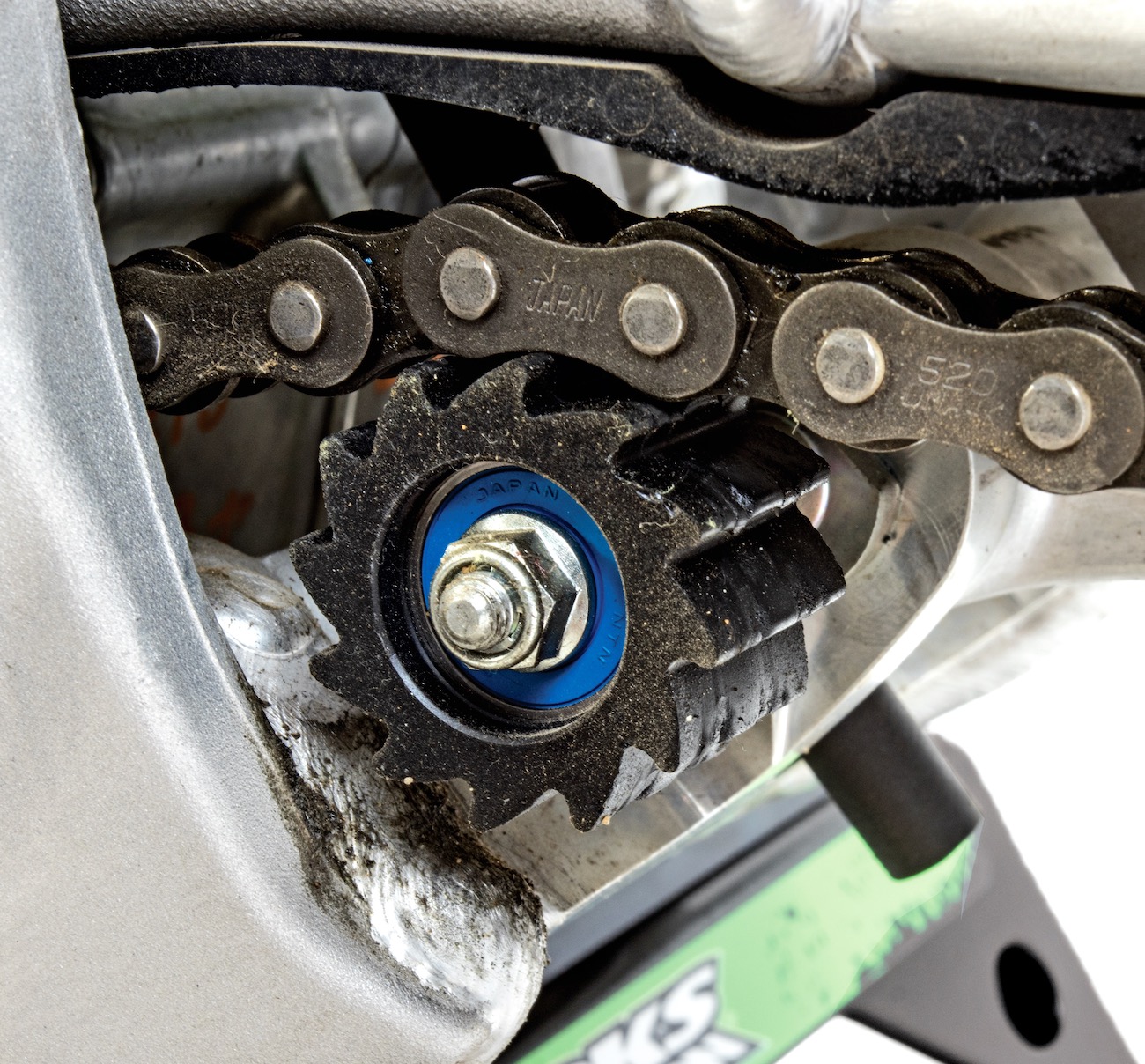 The chain roller under the frame and the chain guide are both suspect—keep and eye on them.
The chain roller under the frame and the chain guide are both suspect—keep and eye on them.
Q: WHAT DID WE HATE?
A: The hate list:
(1) Rear brake pedal. For our tastes, the rear brake pedal could use more downward adjustment range. It is easy to run the brake pedal high but almost impossible to run it low.
(2) Rear brake rotor. The 250mm rear rotor is very touchy and easy to lock up.
(3) Airbox. It requires an 8mm and 10mm wrench to get the convoluted air filter cage arrangement in and out of the incredibly tight and small airbox. User interface is an important part of product design. Consumers expect the designer to build a product that enhances their interaction, not one that slows it down. Two different size bolts that require two different tools to do something that the competition does with fewer tools, one bolt or no tools is a design flaw.
(4) Fork guards. Kawasaki’s fork guards crack when hit by roost. Order aftermarket fork guards when the time comes—and it will.
(5) Shock preload ring. MXA has complained about KTM’s nylon preload ring for a decade. Guess what? Suzuki and Kawasaki copied it. We use a long screwdriver to pry on the preload ring while using the frame as the fulcrum.
(6) Chain rollers. The lower chain roller will self destruct in an amazingly short amount of time. When you buy a chain roller for your KX450, order the complete TM Designworks chain guide at the same time.
(7) Neutral. To get the KX450 into neutral on the starting line, we had to rev the engine and snick the shift lever at max rpm. Paradoxically, every MXA test rider appreciates a bike that has a hard-to-find neutral when they are grabbing gears at speed.
(8) Clutch plates. The 2021 KX450 clutch now requires three different clutch plate part numbers. The outer and inner fiber plates are different from the six middle plates. This is unnecessary complexity.
(9) Rubber bar mounts. There is nothing wrong with the KX450s rubber bar mounts, it’s just that the rubber they use has the density of a marshmallow. Even the slightest tip-over will bend the bars, but, in fact, the bars are not bent, instead the rubber inserts have squished to one side making the whole assembly look out of kilter.
 The KX450 is a fun bike to ride. It feels light, agile and quick at turn-in, and the power delivery works well with the chassis.
The KX450 is a fun bike to ride. It feels light, agile and quick at turn-in, and the power delivery works well with the chassis.
Q: WHAT DID WE LIKE?
A: The like list:
(1) Power. This is an incredibly nice powerband. If that sounds like a description of a potential blind date, that’s because the KX450’s power won’t knock your socks off.
(2) Electric starting.KTM has been using electric start on its race bikes since 2007. Kawasaki joined the party in 2019.
(3) Plain bearings. Kawasaki also followed KTM’s lead when it switched to plain bearings, essentially bushings coated with an anti-friction material. They offer more surface area per contact patch, longer fatigue life, no brinelling and no moving parts—perfect for connecting-rod use.
(4) Handling. Once you stop the forks from blowing through the mid-stroke, the KX450 is a sweet-turning machine.
 In case you’ve never seen a finger follower engine, the cam lobes ride on levers (the green ones), which operate the valves
In case you’ve never seen a finger follower engine, the cam lobes ride on levers (the green ones), which operate the valves
(5) Finger-followers. The KTM was the first motocross bike to come with finger-followers (small levers that activate the valves instead of rocker arms or buckets) over 10 years ago. Honda followed suit in 2017, and the Kawasaki KX450 joined the party in 2019.
(6) Footpegs. The KX450 footpegs can be moved down 5mm if you so desire. On the new chassis, the lower position felt better.
(7) Weight. The 2021 Kawasaki KX450 gained a little weight, but its still in the ballpark with the CRF450, YZ450F and RM-Z450—however, KTM and Husqvarna are playing in a much lighter ballpark in another town.
(8) Clutch. It’s hydraulic, but for 2021 the hydraulics are actually connected to a clutch that works.
(9) Handlebars. Kawasaki held out on going big as long as it could, but with the clutch perch, kill button, launch-control button, electric-starter button, brake perch, throttle assembly and crossbar clamps, Kawasaki had to go to 1-1/8-inch crossbar-less bars to get everything to fit.
Q: WHAT DO WE REALLY THINK?
A: The bars and the clutch make the $9399 2021 KX450 a better motocross bike than it was a year ago. Definitely, not a totally new bike, but at the least, the same bike as last year, but with a totally new clutch. It’s nice, pleasant and fun to race, but maybe Kawasaki should start thinking about more downward brake pedal adjustment, stiffer forks springs, better balance between the front and rear suspension (one is soft and the other is stiff), more power—it’s not the weakest 450 on the track, but it’s the second weakest, getting rid of the jumbo-sized 250mm rear rotor, better engine cooling to cut down on overheating, fork guards, front number plate and radiator shrouds that don’t crack, a bigger airbox and an airbox cover that doesn’t require two different size wrenches to open, green plastic that doesn’t loses its sheen on day one, clutch and brake levers that feel like they came off the same bike and a clutch lever with a better ratio. We love riding it, but living with it requires compromise
MXA’S 2021 KAWASAKI KX450 SETUP SPECS
This is how we set up our 2021 Kawasaki KX450 for racing. We offer it as a guide to help you find your own sweet spot.
SHOWA COIL-SPRING FORK SETTINGS
We have included spring rates for Vets, Intermediates and Pros. They are massively different, and we don’t think that everyone can live happily ever after with the stock spring rate. These are the numbers we ran on the 2021 Kawasaki KX450 for hard-core racing:
Spring rate: 5.1 N/mm (5.0 N/mm for light riders, 5.1 N/mm for Vet riders, 5.2 N/mm for fast riders)
Compression: 14 clicks out
Rebound: 12 clicks out
Fork-leg height: 2mm up (0mm)
Notes: If you have to race with the stock fork springs while waiting to get your forks fixed, slide the forks down in the clamps until the top of the triple clamp is flush with the bottom of the fork cap. Fast riders should set the compression clicker at 6 clicks out. If you don’t think the KX450 is turning as well as it should, slide the forks up in the triple clamps to put more weight on the front wheel and steepen the head angle.
SHOWA SHOCK SETTINGS
The shock worked well from day one, helped by 2019’s new linkage and 105mm of sag. We recommend this shock setup on the 2021 Kawasaki KX450 (stock specs are in parentheses):
Spring rate: 54 N/mm
Hi-compression: 1-1/4 turns out
Lo-compression: 18 clicks out
Rebound: 12 clicks out
Race sag: 105mm
Notes: The shock was easy as pie to set up. The rear end had minimal wallowing and worked very well under braking in chop and square-edged bumps. Light riders under 150 pounds might want to switch to the optional 52 N/mm shock spring.




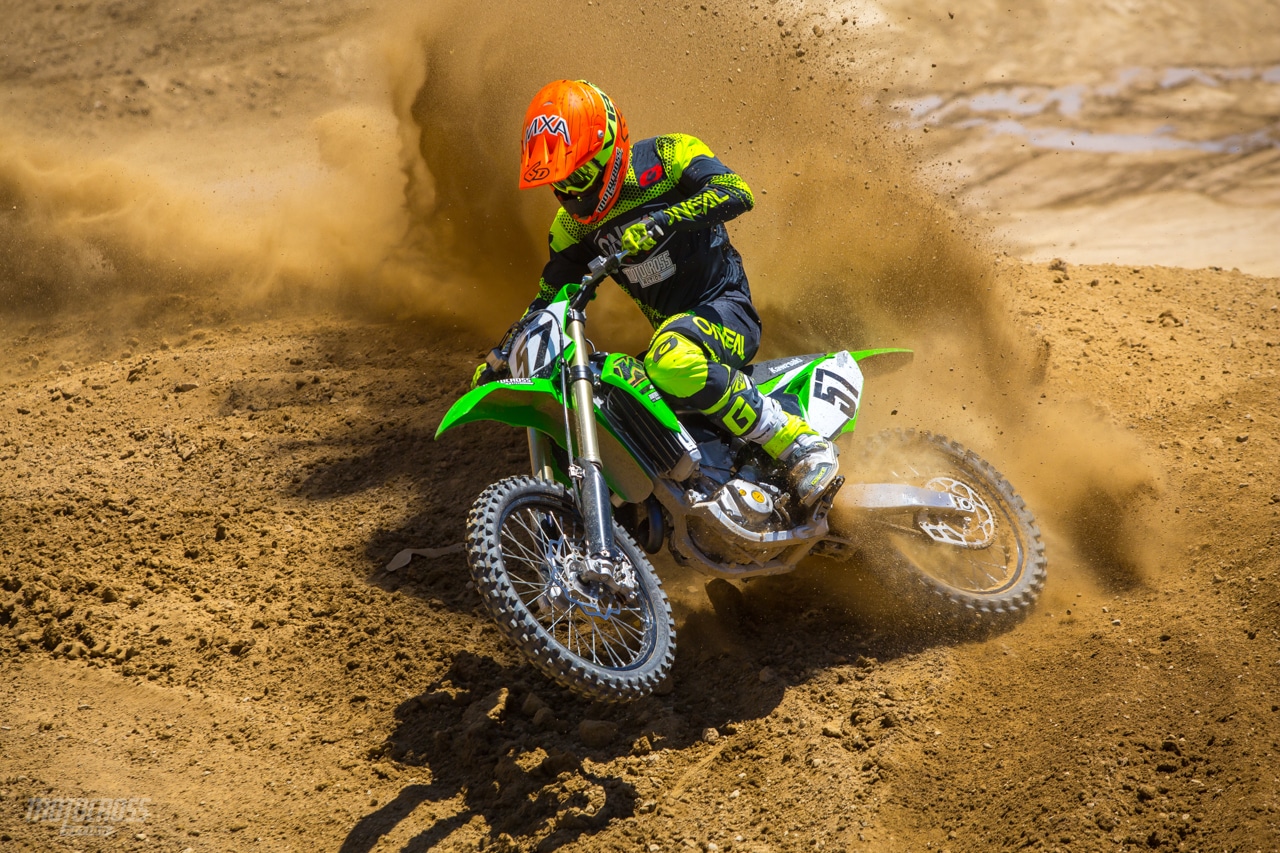
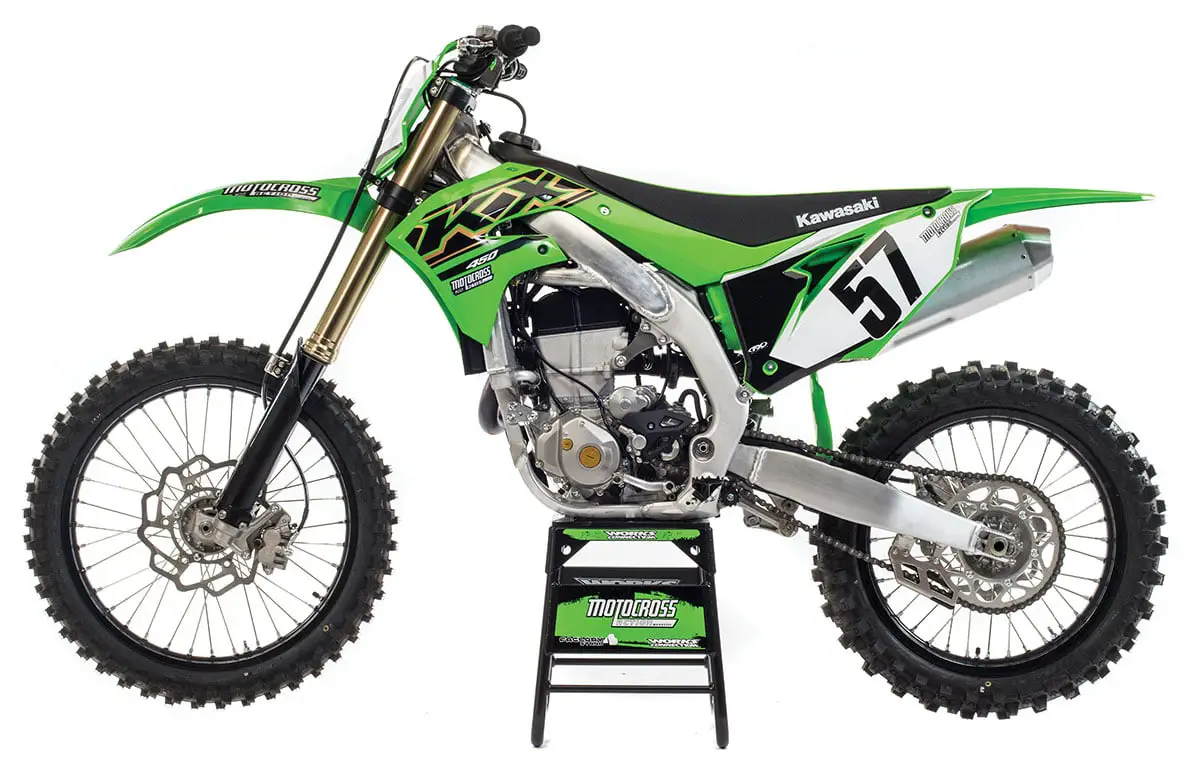



Comments are closed.